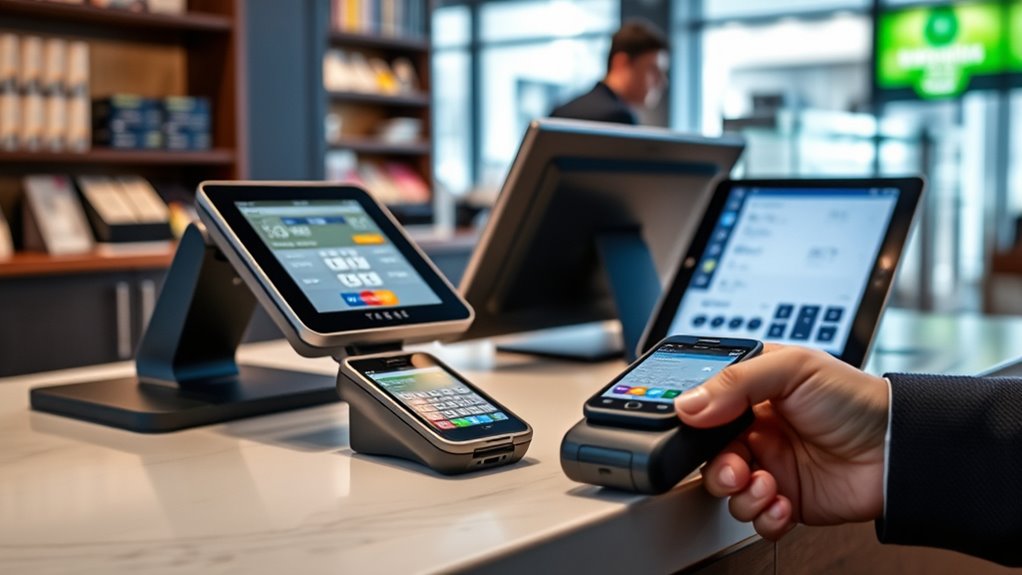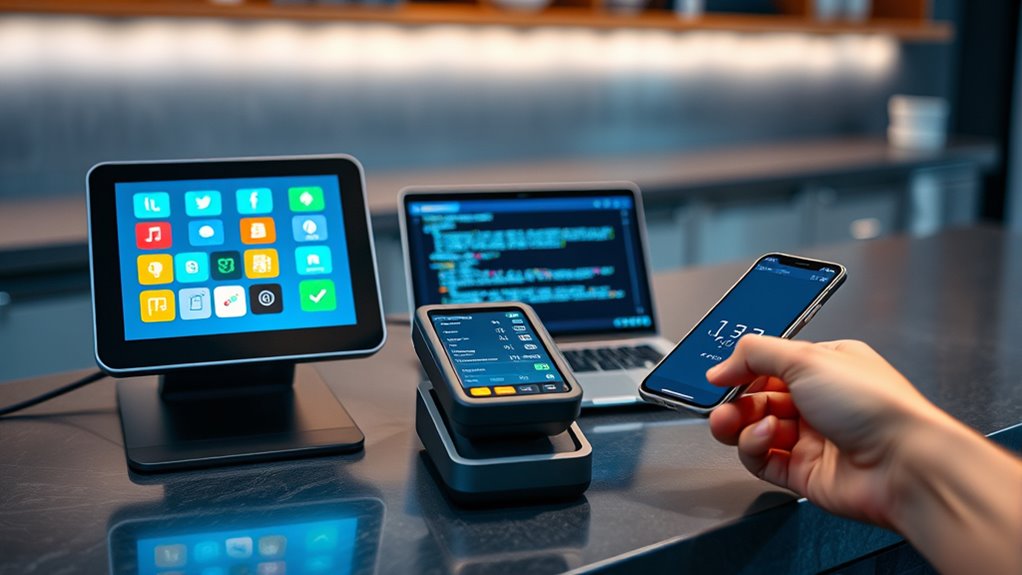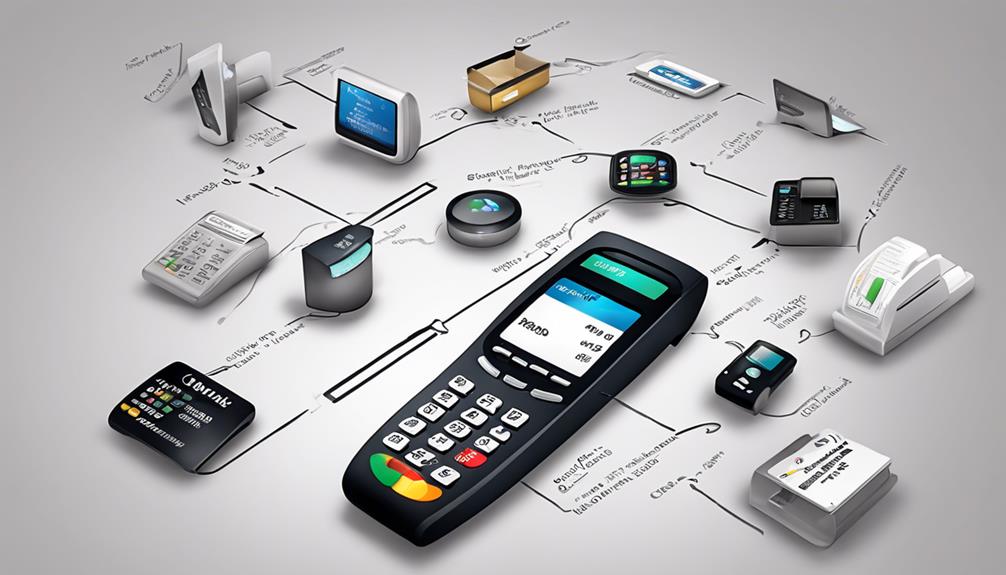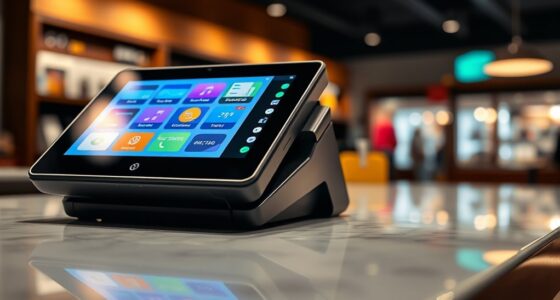Choosing your payment setup depends on your business needs. If you operate a fixed retail store or restaurant, a POS system with hardware and software is ideal for speed and security. For remote or phone orders, a virtual terminal offers convenience without hardware. If you’re on the move, mobile card readers provide quick, portable payment options. Each choice fits different environments; exploring more will help you determine the best fit for your business.
Key Takeaways
- Consider your business location: fixed retail needs POS, remote sales suit virtual terminals, and mobile vendors benefit from mobile readers.
- Evaluate security requirements; POS systems and encrypted mobile readers offer robust protection for sensitive transactions.
- Assess budget and space: virtual and mobile options are more affordable and space-efficient than traditional POS setups.
- Prioritize ease of use and transaction speed to enhance customer experience, especially for high-volume or on-the-go sales.
- Match your business model: fixed stores for POS, remote operations for virtual terminals, and mobile vendors for portable payment solutions.

Selecting the right payment setup is a crucial step in establishing your business or freelance operation. Your choice impacts how smoothly transactions go, how secure customer data remains, and how easy it is for both you and your clients to use. With options like POS systems, virtual terminals, and mobile readers, you need to evaluate what best suits your needs. Security concerns are always at the forefront—you want a setup that protects sensitive information from breaches and fraud. Ease of use is equally important because a complicated system can slow down sales, frustrate customers, and increase the chances of errors.
A POS system, or point-of-sale hardware, is often the go-to choice for retail stores and restaurants. It combines hardware like cash registers, barcode scanners, and receipt printers with software that manages sales, inventory, and customer data. POS systems are generally very secure, especially when they incorporate encryption and compliance features like PCI DSS. However, they can be costly upfront and require dedicated space, which might not be ideal for mobile or freelance operations. The ease of use varies; many modern POS systems are designed with user-friendly interfaces, but learning curves can exist, especially with more advanced features. If you prioritize speed and security in a fixed location, a POS setup might be the best fit. Additionally, the hardware components of POS systems can be integrated with projector technology for visual sales displays or digital signage, enhancing customer engagement.
Virtual terminals serve as a flexible, online solution that allows you to process payments through a web browser. This setup is especially useful if you operate remotely or handle orders via phone or email. Because virtual terminals rely on internet access, security concerns revolve around protecting login credentials and ensuring encrypted transactions. When set up correctly, virtual terminals can be highly secure, but you need to stay vigilant against phishing and hacking risks. Ease of use is generally high—once you’re logged in, entering card details and processing payments feels straightforward. This setup is ideal if you want a simple, portable option without additional hardware. However, it may not be as quick as a POS system for in-person sales, and some clients might prefer paying with physical cards or contactless methods.
Mobile readers offer maximum flexibility, letting you process payments on the go using smartphones or tablets. They’re perfect for vendors at markets, service providers, or freelancers who travel. Security concerns with mobile readers are significant; you want devices that encrypt data during transmission and are compliant with industry standards. Ease of use is one of their biggest advantages, often involving just a few taps to complete a transaction. Many mobile readers integrate seamlessly with existing apps, making it simple to track sales and manage payments from anywhere. Still, because these devices are portable and often connect via Bluetooth or Wi-Fi, you should be diligent about keeping software updated and safeguarding your devices against theft or hacking. If convenience and mobility are priorities, mobile readers could be the best choice for your business.
Choosing a setup that aligns with your business model, budget, and security requirements will help you operate efficiently and securely in the long term.
Frequently Asked Questions
Can I Switch Between Payment Setups Easily?
Yes, you can switch between payment setups easily, giving you great payment flexibility. Most systems are designed for smooth setup changes, allowing you to move from a POS system to a virtual terminal or mobile reader without hassle. This flexibility lets you adapt to different sales environments quickly, ensuring your payment process remains seamless and efficient, no matter which setup you choose at any given moment.
Which Setup Offers the Lowest Transaction Fees?
The setup with the lowest transaction fees often depends on your business size and volume, but generally, virtual terminals tend to have lower transaction fee comparisons than POS systems or mobile readers. You’ll find virtual terminals offer better setup flexibility and potentially lower fees for online transactions. However, always compare the specific rates for each setup, as fees can vary by provider and transaction type, helping you choose the most cost-effective option.
Are There Specific Hardware Requirements for Each Option?
Yes, each setup has specific hardware requirements. A POS system needs hardware compatibility with terminals, cash drawers, and receipt printers, allowing setup customization for your store. Virtual terminals run on any computer or device with internet access, requiring minimal hardware. Mobile readers need compatible smartphones or tablets, with hardware compatibility for Bluetooth or NFC. Your choice depends on your business needs, and each setup offers different levels of setup customization.
How Secure Is Each Payment Method?
You can trust that each payment method offers strong security, thanks to advanced encryption standards that protect your customers’ data. POS systems often include built-in fraud prevention features, while virtual terminals and mobile readers also utilize encryption to secure transactions. By choosing reputable providers, you guarantee your payment methods remain secure, minimizing fraud risks and safeguarding sensitive information during every transaction.
Do I Need Internet Access for All Setups?
Think of your payment setup as a ship steering through different waters. For offline transactions, you’ll need internet access to keep your ship steady, especially with POS systems or mobile readers. Virtual terminals often require a steady connection, but some hardware is compatible with offline modes. Without internet, your ability to process payments depends on your hardware’s offline capabilities—so make certain your setup is prepared to sail smoothly in any condition.
Conclusion
Ultimately, choosing the right payment setup depends on your business needs and customer experience. Whether you opt for a POS system, virtual terminal, or mobile reader, remember that “the right tool is only as good as how you use it.” Consider your sales environment, transaction volume, and mobility needs. Make an informed decision, and you’ll streamline payments, boost efficiency, and keep your customers happy. The right setup can make all the difference—so choose wisely!









